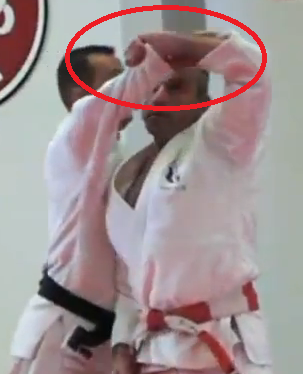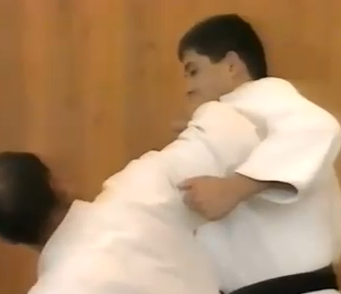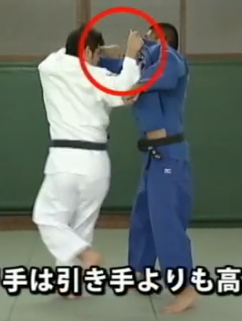I have discussed tsurikomi and correct kuzushi action previously.
However, I never clearly outlined specific drills or routines for people to do to improve their tsurikomi and thus general kuzushi action.
I’m going to split this into two sections –
Static drills
Moving drills
Static drills
The basic tsurikomi drill looks like this:
However, I know from experience that very few people, even supposedly experienced level players like brown belts have trouble going straight into this drill if they’re unfamiliar with it.
So it’s necessary to introduce the drill in two phases –
Sleeve hand action
Lapel hand action
Sleeve hand action
The action of the sleeve hand involves uke’s sleeve being drawn out high so that uke’s wrist is at least level with tori’s forehead, preferable above tori’s head.
As tori draws uke’s sleeve forwards and outwards tori’s wrist must rotate so that by the peak of the pull the palm is facing towards the mat.
The grip starts as normal
And finishes with the hand rotated, palm facing down towards the mat
To drill this action grip uke’s sleeve underneath their elbow, in the classic ‘judo grip’ position and only on their sleeve take no grip of the lapel.
Then repeatedly draw out uke’s sleeve, off balancing uke.
You should be T-ed up with uke as you do this
And best practice is to dip slightly from the hips on the ‘decline’ of the movement and so that you can rise up to normal height on the ‘incline’ of the movement.
It is important to dip slightly on the ‘decline’, because otherwise when attempting to pull upwards on the ‘incline’ you will have a tendency to make yourself go on tip toes, which is obviously totally unrealistic, structurally weak and undermines the practice objectives.
Lapel hand action.
Grip uke’s lapel and lapel only, take no grip on the sleeve and again start T-ed up.
And then apply the tsurite action, bringing the pocket created by uke’s armpit to your forearm lifting simultaneously forwards and upwards.
A major error is to try and pull uke forwards by just jerking them with the arm like so
It is vital that your action brings the pocket created by uke’s armpit to your forearm and to ensure there is no slippage.
The wrist should also be kept straight and inline with the forearm, don’t allow your wrist to bend or flex.
Bringing it together
I would recommend that you practice each hand separately and then practice the two hands together.
If you were designing a set and rep weights type programme for your tsurikomi I would recommend that one set be:
10 sleeve pulls
10 lapel lifts
10 full tsurikomi entries
10 lapel lifts
10 full tsurikomi entries
Do about 3-5 of these sets before and after every Judo session.
Concentrate on quality rather than quantity.
All sets should be down concentrating on smoothness and coordination of the action.
If it isn’t smooth and coordinated go back and start again.
Remember: First get it right, then get it fast.
Increase the reps in each set as competency- fluidity and coordination -improve i.e
15 sleeve pulls
15 lapel lifts
15 full tsurikomi entries
15 lapel lifts
15 full tsurikomi entries
20 sleeve pulls
20 lapel lifts
20 full tsurikomi entries
20 lapel lifts
20 full tsurikomi entries
Etc...
Moving drills
The above outlined static drills are excellent for improving your basic tsurikomi skills and will produce improvements in your static uchikomi and nagekomi.
However, at some point you will have to do some moving uchikomi, nagekomi or maybe even randori...
In a basic moving tsurikomi drill, as demonstrated by Inoue.
Tori retreats normally and then performs a backwards tsugi ashi step.
Note how tori sinks as he takes the tsugi ashi step, this facilitates him off balancing uke without raising his own COG.
This drill should be performed with multiple repetitions down the mat.
Again the focus should be fluidity and accuracy rather than speed and showy-ness.
When basic competency has been achieved with moving tsurikomi drilling as outlined above then more advanced drills can be done.
Note how tori only moves in tsugi ashi and uke is squatting to increase resistance for tori.
These moving drills can also be introduced in a phased manner as with the static drills where tori drills first the sleeve action in isolation and then the lapel action in isolation.
These isolation drills can be particularly effective in correcting problems with someone’s tsurikomi action.
Conclusion
I would strongly advise any Judoka who is serious about their Judo to devote time to practicing these drills under competent supervision.
I personally have done thousands of tsurikomi uchikomi like this:
And covered several miles of mat doing this
My coach would start every session with us doing about 5 sets on 20 static tsurikomi uchikomi- ‘half turns’ as he calls them. And my mate and I would book out a room on campus and spend 2 hours just drilling where we would do a couple of hundred tsurikomi drills static and moving apiece along with uchikomi for our tokuiwaza.
That’s not an example of badassery. That’s something anyone can achieve if they put their mind to it and are willing to put the hours in.
If you can’t get two hours on a mat to drill these things or your coach won’t give you the time to drill them. Then turn up 10 minutes early and stay 10 minutes late after each session and drill these with a partner or long suffering friend.
If you have absolutely no alternatives than attach a pair of bicycle inner tubes to the garage wall, draw a triangle in chalk and then practice doing your tsurikomi and observing the triangle.
Or if you don’t have a garage then shove a pair of innertubes in a rucksack with some pieces of chalk and go for a jog down to the park before or after work, mark out your triangle and attach your inners and get doing those half turns.
Practicing these drills will improve your throws and will help you throw more people more often. I can’t guarantee it will be immediate for you, but if you keep at it you will improve, you will get better and you will throw more people.
I promise.










